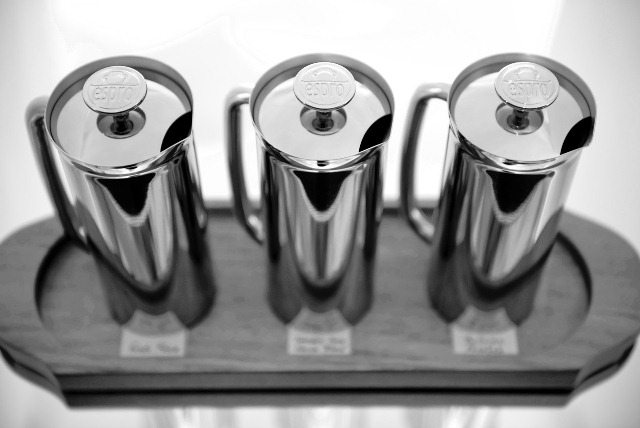By Vicki Matranga, Design Programs Coordinator
Get to know the people behind the stylish, thought-provoking designs that will be exhibited in Discover Design. This series of conversations will give you a glimpse of the inspirations, influences and ideas that go into creating the exciting products that you’ll see at the 2013 Show.
Based in Vancouver, British Columbia, Canada, Espro aims to bring the best cup of coffee to every table. In 2002, Bruce Constantine and Chris McLean met for a coffee and sketched on the back of a napkin their first product concept – a way to make it easier to brew good espresso. Their experience in business development and engineering pressed them to reinvent a traditional kitchen product. By April 2004, Espro™ had emerged. The first years were devoted to a series of inventions to improve the consistency of espresso and milk foam, followed by a period of extensive R&D efforts to improve the efficiency of the French Press. With its range of innovative products designed to achieve consistently great results in making espresso and coffee, Espro delivers a clean, grit-free cup for coffee lovers who prefer pressed coffee. Along the way they have learned that improving coffee requires action from everyone – farmers, roasters, equipment innovators, shops, restaurants and passionate consumers. Their Espro Press, a double wall stainless steel vessel with vacuum insulation, launched with Kickstarter funding in 2012.
We’re speaking with Chris McLean, vice president of product development and co-founder.
Chris, where do you find inspiration when designing new products?
I think there are two places – an outer place and an inner place. The outer place is for finding problems, the inner for solving them.
Problems are the start of any good design, but they are found out in the world, so you need to go to them. I find them by observing people experiencing frustration or by experiencing their frustration with them.
The inner place is for finding creative solutions. It is not as important where I am, but I need to have a notebook or laptop to record the inspiration.
Are there any specific designers, places or eras that influence you?
I am certainly inspired by the coffee community. Roasters, café’s and the passionate people brewing and serving coffee inspire me to be passionate about my work.
How do you choose which idea to take to the next step — to product development?
I use a fairly mechanistic approach. I create rating criteria, based on what the customer wants, and I weight the important criteria higher. Each idea is rated against the criteria, and the best solution moves forward. Sometimes I do this for complete design options, but I also do this for subsets of the design. This approach truly makes me struggle with the trade-offs that are designed into every product and forces me to make the same decisions around these trade-offs that the customer would make.
How do you identify the key user audience for your products?
I use a process called Quality Function Deployment (QFD), which captures customer wants and translates them into the important design parameters. We also try to avoid commodities, and tend to focus on audiences that are passionate about design.
Is there an approach or look that joins the functionality, form or emotional appeal of your product line?
As all of our designs are hand tools for brewing coffee, we try to design forms that people want to pick up and hold. When someone can’t stop themselves from picking up one of our products, we know we have succeeded!
How do you see design’s importance in our industry as it moves forward?
Design is part of what makes a product remarkable. If people are not talking about your product, your product will be lost in the noise.
Where are your products manufactured?
Our machined and molded parts are made in both Canada and the US. Our formed parts (sheet stainless steel parts) are made in Asia.

What advice can you offer to designers working in the home goods field?
1. Always start with a problem. The more painful and expensive the problem is, the more important the solution will be to the customer.
2. Break the problem down into many small independent problems. The simpler each problem is, the simpler it is to solve.
3. Brainstorm many solutions. The more possible solutions you have, the better the actual solution will be.
4. Out of all the possible solutions, make sure you chose the one that the customer would.
5. Brainstorm what can go wrong with the design before you launch it. Finding (and solving) problems on paper is easier and cheaper.
How does Discover Design help to expand your brand?
The Espro brand is well established in the specialty coffee community and as we look to expand our brand awareness to a wider consumer audience, Discover Design provides a great platform for showcasing our product and brand to the housewares industry.
 Thank you, Chris, for sharing your story of how you built your business upon your approach to design. Sounds like a recipe for success. Do people call you “Mr. Coffee”? We look forward to savoring your offerings at your booth in Discover Design S4280.
Thank you, Chris, for sharing your story of how you built your business upon your approach to design. Sounds like a recipe for success. Do people call you “Mr. Coffee”? We look forward to savoring your offerings at your booth in Discover Design S4280.
Learn more about Espro’s founders Bruce and Chris and their commitment to flavorful brew at www.espro.ca
Discover Design is the premier design destination at the International Home + Housewares Show. Located in the South Building, within the Dine + Design Expo, the invitation-only category features more than 100 exhibitors from around the world. Companies driven by innovation and inspired by design present distinctive products and collections in Tabletop, Gift, Textiles and Home Décor categories. Exhibitors are selected to participate by a panel of industry experts comprised of retailers, design journalists and peers. Some exhibitors appeared here last year, many are new to our Show. The Discover Design Gallery, accessible to buyers and media, features select products that are entries in the Global Innovation Award (gia) for Design. Learn more about Discover Design exhibitors and their products by checking Housewares Connect 365 at www.housewares.org


